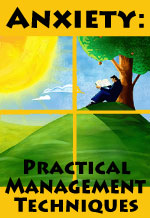By Lisa M. Schab, MSW, LCSW
 Nearly every client who walks through a health professional’s door is experiencing some form of anxiety. Even if they are not seeking treatment for a specific anxiety disorder, they are likely experiencing anxiety as a side effect of other clinical issues. For this reason, a solid knowledge of anxiety management skills should be a basic component of every therapist’s repertoire. Clinicians who can teach practical anxiety management techniques have tools that can be used in nearly all clinical settings and client diagnoses. Anxiety management benefits the clinician as well, helping to maintain energy, focus, and inner peace both during and between sessions.
Nearly every client who walks through a health professional’s door is experiencing some form of anxiety. Even if they are not seeking treatment for a specific anxiety disorder, they are likely experiencing anxiety as a side effect of other clinical issues. For this reason, a solid knowledge of anxiety management skills should be a basic component of every therapist’s repertoire. Clinicians who can teach practical anxiety management techniques have tools that can be used in nearly all clinical settings and client diagnoses. Anxiety management benefits the clinician as well, helping to maintain energy, focus, and inner peace both during and between sessions.
Since one of the greatest obstacles to practicing anxiety management is finding the time and energy to actually do the exercises, one of the basic challenges in teaching these techniques is convincing the client that it is a realistic practice. Many people view adding anxiety management techniques to their life schedule as an imposition. Most are already overloaded with the responsibilities of daily life (which contributes to their anxiety) and the thought of having to add more responsibilities to that mix can appear a daunting or unrealistic task (and raise their anxiety even more). Therefore, this course is designed to provide a majority of techniques that can be used simply, in a short period of time, and can be incorporated into daily life with as little disruption as possible.
Anxiety management techniques are most effective when presented in a manner that gives the client the hope that they can actually practice them. Two key questions that help to achieve this are: “Do you breathe?” and “Do you think?” When the client answers, “yes,” you can then inform them that they are already practicing the two most powerful tools for staying calm. However, the way they are using the tools may be contributing to their anxiety rather than diminishing it. Success can be achieved when they simply learn to use their tools in a different way.
The two premises behind the effectiveness of these tools – breathing and thinking – are basic physiology and Cognitive Behavioral Therapy. Physiology tells us that the depth and speed of our inhalations and exhalations will affect the amount of tension in our bodies. The amount of oxygen flowing in and out of our bodies will also affect our ability to think clearly. Cognitive Behavioral Therapy instructs us that the way we think determines our feelings. The thoughts we choose at any given moment will directly and significantly affect our anxiety level.
Since breathing and thinking are behaviors that are practiced constantly, no matter where a client is or what they are doing, clients can then understand that they will have the time and the energy to use these two important tools realistically and practically in their daily lives. They need no special equipment, no scheduled appointment, no special block of time, and no particular location. These are tools that they carry with them and can use at every single moment. Two of the sections which follow – those on breath work and cognitive restructuring – address these physiological and cognitive techniques in detail. A great number of exercises in the other sections are also based on these two techniques.
Learn more and earn 4 hours of continuing education credits by taking the Anxiety: Practical Management Techniques online CE course. Nearly every client who walks through a health professional’s door is experiencing some form of anxiety. Even if they are not seeking treatment for a specific anxiety disorder, they are likely experiencing anxiety as a side effect of other clinical issues. For this reason, a solid knowledge of anxiety management skills should be a basic component of every therapist’s repertoire. Clinicians who can teach practical anxiety management techniques have tools that can be used in nearly all clinical settings and client diagnoses. Anxiety management benefits the clinician as well, helping to maintain energy, focus, and inner peace both during and between sessions. The purpose of this course is to offer a collection of ready-to-use anxiety management tools. Course #40-12 | 2007 | 41 pages | 30 posttest questions
This online course provides instant access to the course materials (PDF download) and CE test. Successful completion of the online CE test (80% required to pass, 3 chances to take) and course evaluation are required to earn a certificate of completion. You can print the test (download test from My Courses tab of your account after purchasing) to mark your answers on it while reading the course document. Then submit online when ready to receive credit.
Professional Development Resources is approved to offer continuing education by the American Psychological Association (APA); the National Board of Certified Counselors (NBCC); the Association of Social Work Boards (ASWB); the American Occupational Therapy Association (AOTA); the American Speech-Language-Hearing Association (ASHA); the Commission on Dietetic Registration (CDR); the California Board of Behavioral Sciences; the Florida Boards of Social Work, Mental Health Counseling and Marriage and Family Therapy, Psychology & School Psychology, Dietetics & Nutrition, Speech-Language Pathology and Audiology, and Occupational Therapy Practice; the Ohio Counselor, Social Worker & MFT Board; the South Carolina Board of Professional Counselors & MFTs; and by theTexas Board of Examiners of Marriage & Family Therapists and State Board of Social Worker Examiners.












